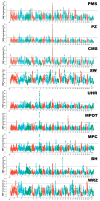Exploring Runs of Homozygosity and Heterozygosity in Sheep Breeds Maintained in Poland
- PMID: 40565601
- PMCID: PMC12192788
- DOI: 10.3390/genes16060709
Exploring Runs of Homozygosity and Heterozygosity in Sheep Breeds Maintained in Poland
Abstract
Objectives: The study investigates runs of homozygosity (ROH) and heterozygosity (ROHet), and their patterns in nine sheep breeds (772 animals in total) maintained in Poland (native and conserved), corresponding to their genetic diversity, inbreeding levels, and selection signatures. Methods: Genotypes were obtained using the Illumina OvineSNP50 BeadChip and quality-filtered SNPs were used to detect ROH and ROHet segments with the detectRUNS R package, following stringent parameters for segment length, SNP density, and genotype quality. Results: Significant variation in ROH characteristics was observed across breeds. Short ROH segments were predominant in all breeds, indicating historical inbreeding events. In contrast, longer ROH segments signified recent inbreeding, particularly in Swiniarka (SW) and Polish Merino of Colored Variety (MPC). The ROH-based genomic inbreeding coefficient (FROH) varied across breeds, with SW exhibiting the highest levels, suggesting reduced genetic diversity. ROHet analysis revealed that Uhruska (UHR) had the highest heterozygous segments span, while Black-headed (BH) sheep exhibited the lowest ROHet extent. ROH islands identified across breeds revealed regions under selection, associated with traits such as reproductive performance, wool quality, and body condition. Genes located within these islands (e.g., U6, SPP1, ABCG2) were linked to economically significant traits including milk production, growth, and carcass quality. Conclusions: The presented results highlight the genetic adaptations shaped by selection pressures, while also providing insights into the genetic architecture of sheep breeds maintained in Poland.
Keywords: ROH; autozygosity; breed diversity; inbreeding coefficient.
Conflict of interest statement
The authors declare no conflicts of interest.
Figures






Similar articles
-
Examination of Runs of Homozygosity Distribution Patterns and Relevant Candidate Genes of Potential Economic Interest in Russian Goat Breeds Using Whole-Genome Sequencing.Genes (Basel). 2025 May 24;16(6):631. doi: 10.3390/genes16060631. Genes (Basel). 2025. PMID: 40565522 Free PMC article.
-
Runs of homozygosity analysis of South African sheep breeds from various production systems investigated using OvineSNP50k data.BMC Genomics. 2021 Jan 6;22(1):7. doi: 10.1186/s12864-020-07314-2. BMC Genomics. 2021. PMID: 33407115 Free PMC article.
-
Exploring genetic diversity and genomic inbreeding across local beef cattle breeds.Animal. 2025 Jul;19(7):101565. doi: 10.1016/j.animal.2025.101565. Epub 2025 Jun 5. Animal. 2025. PMID: 40580843
-
Runs of homozygosity: current knowledge and applications in livestock.Anim Genet. 2017 Jun;48(3):255-271. doi: 10.1111/age.12526. Epub 2016 Dec 1. Anim Genet. 2017. PMID: 27910110 Review.
-
Intravenous magnesium sulphate and sotalol for prevention of atrial fibrillation after coronary artery bypass surgery: a systematic review and economic evaluation.Health Technol Assess. 2008 Jun;12(28):iii-iv, ix-95. doi: 10.3310/hta12280. Health Technol Assess. 2008. PMID: 18547499
References
-
- Curik I., Ferencakovic M., Solkner J. Inbreeding and runs of homozygosity: A possible solution to an old problem. Livest. Sci. 2014;166:26–34. doi: 10.1016/j.livsci.2014.05.034. - DOI
-
- Kizilaslan M., Arzik Y., Behrem S., White S.N., Cinar M.U. Comparative genomic characterization of indigenous fat-tailed akkaraman sheep with local and transboundary sheep breeds. Food Energy Secur. 2023;13:e508. doi: 10.1002/fes3.508. - DOI
MeSH terms
Grants and funding
LinkOut - more resources
Full Text Sources
Research Materials
Miscellaneous

